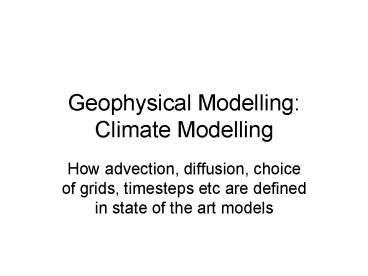Geophysical Modelling: Climate Modelling PowerPoint PPT Presentation
Title: Geophysical Modelling: Climate Modelling
1
Geophysical ModellingClimate Modelling
- How advection, diffusion, choice of grids,
timesteps etc are defined in state of the art
models
2
Example The UK Met Office Unified Model
- Same basic model is used for
- Global numerical weather prediction (i.e.
operational weather forecasting) - Regional NWP
- Climate modelling
3
Model dynamics
- Solves the primitive equations (Navier-Stokes
Equations) on a rotating sphere. - Prognostic equations for (u,v,w), ?, q,
hydrometeors, etc. - Mass continuity equation.
- Variables are initialised (at t0), and are
functions of (x,y,z,t), so prognostic equations
are used to march forward in time and space.
4
Model physics
- Many processes are sub grid scale and hence
cannot be resolved - These are parameterised
5
Model physics
- Many processes are sub grid scale and hence
cannot be resolved - These are parameterised
- convection
- Cloud microphysics, precipitation etc
- Turbulence and heat exchange within boundary
layer - Radiative transfer (interactions with trace gases
etc) - Drag by mountains, gravity waves,etc
- Land surface processes
6
Dynamical equations
7
(No Transcript)
8
(No Transcript)
9
Old Dynamics New Dynamics
Hydrostatic Non-hydrostatic
Pressure based hybrid coordinate Height based hybrid coordinate Charney Phillips grid staggering
Arakawa-B grid Arakawa-C grid
Semi-implicit eulerian advection 2 time level semi-lagrangian advection
Richardson number based boundary layer scheme Equilibrium stable boundary layer scheme
Mass flux convection scheme with buoyancy closure Mass flux convection scheme with cape closure
Linear hydrostatic GWD scheme Warner and McIntyre type gravity wave drag scheme
Met Office Surface Exchange Scheme MOSES I Surface hydrology and soil model MOSES II
Standard Smith cloud scheme Standard Smith cloud scheme with prognostic cloud ice
10
Model Grid
11
UM Horizontal grid
12
UM Vertical Grid
13
A climate simulation from climateprediction.net
14
(No Transcript)
15
(No Transcript)
16
(No Transcript)
PowerShow.com is a leading presentation sharing website. It has millions of presentations already uploaded and available with 1,000s more being uploaded by its users every day. Whatever your area of interest, here you’ll be able to find and view presentations you’ll love and possibly download. And, best of all, it is completely free and easy to use.
You might even have a presentation you’d like to share with others. If so, just upload it to PowerShow.com. We’ll convert it to an HTML5 slideshow that includes all the media types you’ve already added: audio, video, music, pictures, animations and transition effects. Then you can share it with your target audience as well as PowerShow.com’s millions of monthly visitors. And, again, it’s all free.
About the Developers
PowerShow.com is brought to you by CrystalGraphics, the award-winning developer and market-leading publisher of rich-media enhancement products for presentations. Our product offerings include millions of PowerPoint templates, diagrams, animated 3D characters and more.

